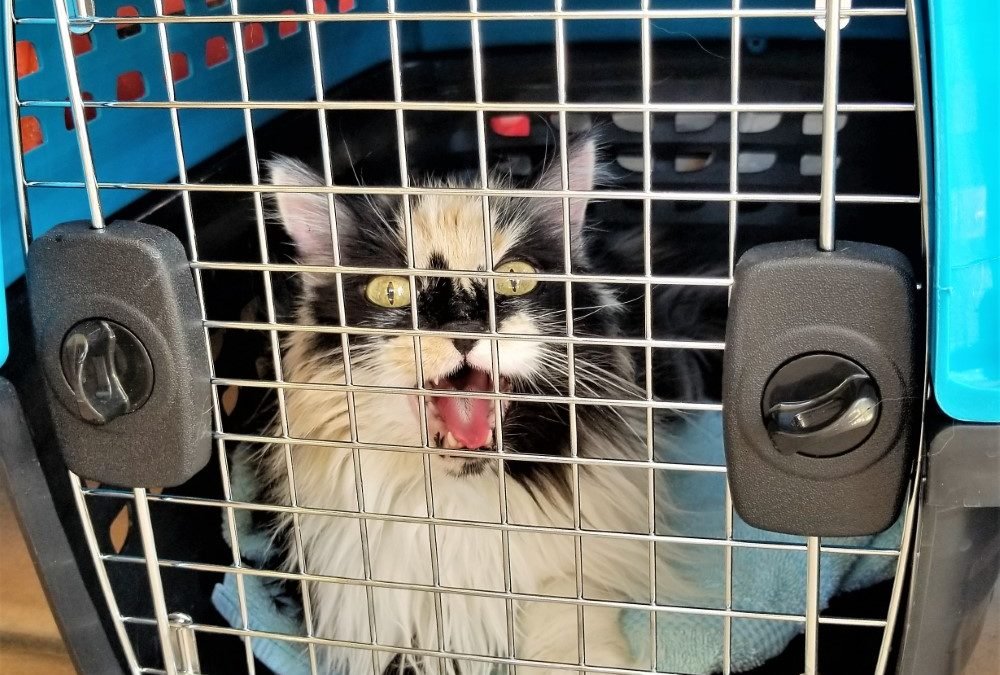Getting on a plane with a cat does take time, research, and planning. As you know most cats even dislike car rides, let alone plane trips. Going to the vet can be a harrowing experience in itself let alone flying with cats!
Airlines also have their regulations and rules, so this can complicate this situation even more. Cats do not like confined spaces and unlike dogs do not consider a cage or a carrier as a den. Now, you can train a cat to like its carrier but that usually only occurs when the carrier entrance is left open.
As long as a cat does not feel trapped things go smoothly but when you zip up the entrance, then, of course, the squealing and rummaging about in it occurs.
Table of Contents
Flying With Cats Takes Preparation
Line and pad the carrier you are going to use pre-flight with soft cozy materials on the bottom of course, but even if you can, on the sides. A soft carrier will work best, as you will need to put it under the airline seat if this is allowed by the airline.
Sturdiness is of utmost importance, as a cat’s claws, especially on a long flight can work miracles, so a double zipper type, with a super-strong zipper, is a good choice. Leather holds up much better than material soft carriers depending upon how strong a cat is.
Kittens do not have the strength of agile younger cats, and older cats also will not have as much strength although the yowling can be intense. Many cats when upset can vomit, defecate or urinate, and this will be upsetting if this is the first airline flight for a cat, so bring clean-up materials for both the cat and the carrier.
Wet wipes for cats do exist and there is a strong possibility that you will need these.
The Choice of Airline Counts and Length of Flight
Not all airlines will allow you to board with your cat and keep the carrier under the seat. All airlines have ‘pet approved’ types of carriers so make sure you know what is possible before booking a flight.
Any animals with some airlines must use animal transport which means they are in storage at the bottom of the plane. This may make your cat very nervous and upset and you as well. The airlines are not doing this for spite, but for the comfort of all passengers, as some passengers might be allergic to cats or do not want to share a flight with any animal.
Do not forget that on longer flights especially, your cat may yowl, and if another passenger complains you can be asked to deboard at the next flight stop.
Animal Flight Concierge Services Exist
If you think the whole trip and flight through, and it seems ‘iffy’ at best, there are animal flight concierge services that exist. These are expert pet transporters, and while not cheap, your cat will be transported in coach and not a cargo port. In addition, there are pet nannies on board to help alleviate your cat’s discomfort.
Finding one of these operational services, that will alleviate all worry might be the solution to your problems of transporting your beloved puss. Arrangements must be made well ahead of time and coordinated with your airline, as these are separate animal transports.
An ESA (Emotional Support Animal) is Generally Allowed
Most airlines do make exceptions for ESAs but most cats are not approved as ESA animals even though we know they provide emotional support. If using a pet flight concierge service make sure someone is hired to be at the arrival destination in case your flight is delayed.
Yes, it does cost more again too, but might be well worth the money. If your cat is approved as an ESA you still need to check with the airline on their restrictions on bringing your cat onboard. Most individuals do not realize even if a cat is allowed onboard, or even transported via the cargo area, a visit to the vet is necessary just before making flight plans.
Airlines, all of them, do require a Veterinary Health Certificate before allowing any animal onboard a plane no matter what part of the plane the animal is located. This is a crucial step!
Remember, Treats and Toys Work Wonders
If you have jumped through all the hoops, and can indeed travel via airplane with your puss face, you need to factor in lots of time for breaks if you can board with them under the seat.
Most individuals do not read the fine print on the airline sites or the tickets. Becoming upset, your cat can make the airline disengage you at the next stopover as stated before. You won’t be catching a quick cat nap, at any rate, as effectively giving your cat treats at intervals, or playing with them for the entire flight helps immensely.
Although an airline might allow you to take your cat out of their carrier, this is not recommended. Cats can freak out easily and well-meaning children or adults might go to pet them or pick them up, which in turn might make them bolt. Needless to say, that is the kiss of cat death for your flight, and the next stop is your last stop, with that airline.
Cats Love Familiarity
So also make sure that you have one or two favorite blankets which all cats usually have. One for the carrier and one for your arms or lap in case you do need to take your feline out for a clean-up or just a brief rest. This will calm them immensely and alleviate problems.
Generally speaking, unless you are flying a short distance, or using a transport service, flying with a cat is not going to be easy. It is worth remembering that if you are only visiting someone or going on vacation it might be wiser to just arrange for a pet sitter at home until you are back.
FAQs About Bringing Your Cat on an Airplane
What documents do I need to bring to take my cat on a plane?
The documents required to take your cat on a plane can vary depending on the airline and the destination. However, most airlines require a health certificate issued by a veterinarian within 10 days of the flight, as well as proof of up-to-date vaccinations. Some airlines may also require additional documents, so it’s important to check with the airline ahead of time.
How do I prepare my cat for a flight?
It’s important to make sure your cat is comfortable with their carrier before the flight, so they feel safe and secure during the trip. You can also help your cat adjust to the carrier by leaving it out for them to explore and even offering treats inside. Additionally, you should avoid feeding your cat a large meal right before the flight and provide plenty of water.
Can my cat ride with me in the cabin?
Many airlines allow cats to ride in the cabin with their owners, but this can depend on the size of the cat and carrier, as well as the airline’s specific policies. Some airlines may also have restrictions on the number of pets allowed in the cabin, so it’s important to check with the airline ahead of time.
What if my cat gets anxious or uncomfortable during the flight?
Some cats may become anxious or uncomfortable during the flight, especially if it’s their first time traveling. To help keep your cat calm, you can try using a calming pheromone spray, playing soothing music, or covering the carrier with a blanket. You can also talk to your veterinarian ahead of time about any potential medication options that may help your cat stay relaxed during the flight.

Jonathon Hyjek is an entrepreneur and cat-lover. He is married to Joy and they share their home with their 2 feline-friends, Franklin & Ollie. Jonathon is a self-admitted “Crazy Cat Guy”. He started this website because of his love for his own cats and their well-being.

